Weather and it’s impact on hiking
Hiking practice
Every time we head out into the bush for the day the one factor that we must deal with on every hike is the weather. Good or bad, the weather can make or break a hike and if we fail to pay attention to extreme weather conditions it can also present safety concerns.
This article discusses factors to consider when planning your hike as well as what to look for during the hike itself to ensure that you not only enjoy yourself but remain safe at the same time. You can also listen to this article as a podcast here.
First let’s look at what we mean by ‘perfect weather’. From my perspective there is no such thing as perfect weather. You could be forgiven for thinking that sunny conditions with a gentle breeze with temperatures between 18-24° celsius would be ideal and in most cases, I would agree with you. However if that is what we had day in, day out, then this would become a bit boring. You need the bad to appreciate the good.
Now I’m a bit of a photography buff and while I’ll never earn a living as a photographer I take some pretty amazing photos every so often and some of the best ones have been in weather most people would consider less than perfect. You might be looking at doing a two hour hike and decide not to go if it’s raining and that’s fine but as the saying goes
“There are no rainbows without rain”.
Each us will have a limit on what we consider as an acceptable amount of bad weather. I don’t mind hiking in gale force winds and torrential rains so long as that’s not the norm over the majority of a hike. From my perspective there comes a time when I will say enough is enough and call it quits, or for that matter not even go. It’s your call and as we recently discussed Hike Your Own Hike (HYOH).
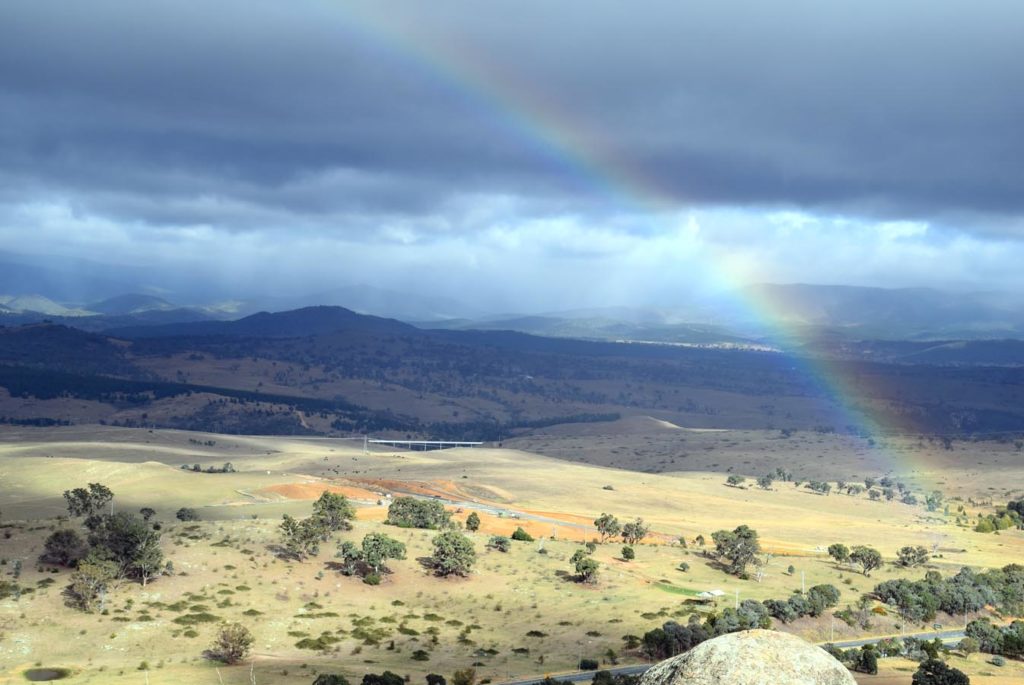
You aren’t going to get images like this in perfect weather. A little bit of rain every now and then is worth it to get some great photos like this image from Mt Painter in Canberra shows
Before we go hiking
So, every time we decide to go out hiking be it for a few hours or multiple weeks we need to look at what the weather conditions are doing. The length of a hike will determine what factors you need to consider and how you should proceed.
Day Hikes
If you are hiking for a single day or less, you should be checking the short term weather forecast for the rest of the day to ensure we have the appropriate equipment/clothing for your outing. With most people having smart phones this is very easy to do or failing that the internet or local newspaper, preferably just published.
I can’t stress enough here to check the forecast for the next day just in case. I mean how many times have you seen the forecast be for sunny conditions with no rain for today’s weather and rain forecast for the following day only to have a front move in quicker than expected and the rain that was supposed to occur tomorrow comes in earlier than planned.
A good example here was a walk we did to the summit of Mount Kosciusko from the chairlift on Christmas day a few years ago. When we started the walk the temperature was 25° celsius but within a matter of half a day that we were out on our walk the temperature had plummeted to 4°celsius. I could only watch with amazement as families with you children including one 5 year old girl wearing sandals and a lightweight dress just keep on going. The Australian Alps is well known for is highly variable and rapidly changing weather conditions, so you need to come prepared.
Longer Hikes up to 7 days
Hiking over multiple days and anywhere up to a week you can be reasonably sure that the weather forecasters have it right. Again, my comment here would be to cater for the worst case forecast and this may mean that you carry wet weather gear needlessly. An example here is the Overland Track. You should expect to get rain on the track for at least one day regardless of the time of year, and possibly snow.
You could be forgiven here of thinking that the Overland Track is a death trap when you read the official website that sets out all the gear you need to take as well as all the considerations. In many cases the gear is overkill however as one of Australia’s most popular tracks many people who hike it have little overnight hiking and camping experience and may not even bother to consider the weather, so the website has been aimed at the worst case situation. The excessive warnings on this track aren’t aimed at experienced hikers but are meant as a reminder to make sure we have consciously thought about what we are doing.
Week long+ Hikes
Once you start hiking for longer than a week then really you have no option but to ensure that you cater for the worst possible conditions for the time of the year and the location that you are hiking. I’ll use the Larapinta Trail here in Australia Northern Territory. Most people that undertake this walk complete it in somewhere between 10-20 days. We hiked this trail in August of 2016 and in the month prior to our trip the temperatures ranged from -4° celsius at night on one occasion to 32° celsius at its hottest during the day. This is a pretty extreme temperature fluctuation but given that it’s almost impossible to forecast for such a long period with any degree of accuracy we worked on this temperature range for our trip as well. We ended up with temperatures ranging from 0-32º celsius on our trip, so we weren’t too far off what we had planned for. The other consideration on this trail is rain with the expectation of a rainy day about every 10 days of your hike. What can happen in this part of Australia is flash flooding and the water levels and the creeks can rise quite rapidly even when the rain occurs 20-30km away. Be careful about sleeping in dry creek beds as you may wake up being wet.
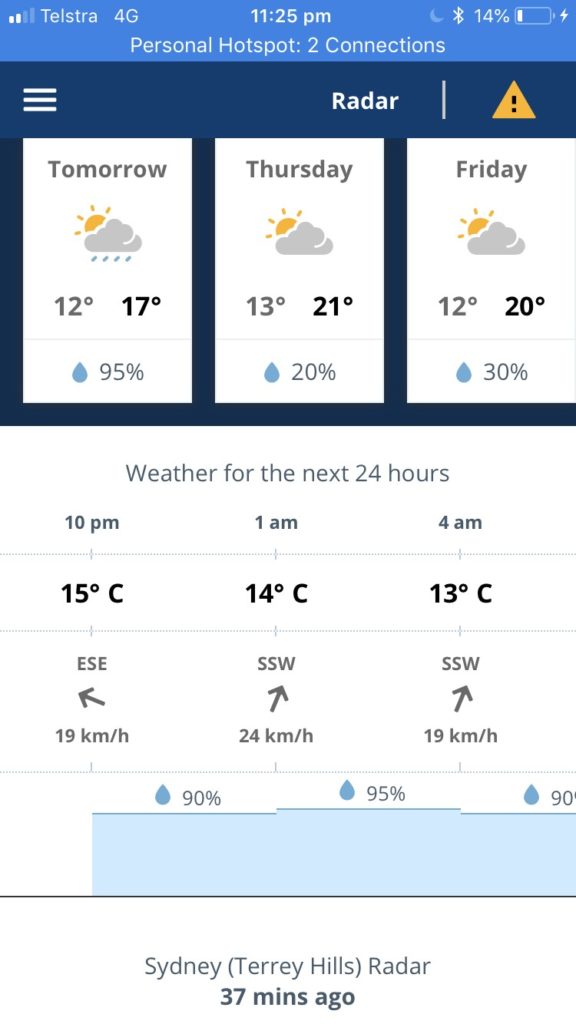
Smart phones are an easy source of weather forecasts for the local or interstate areas
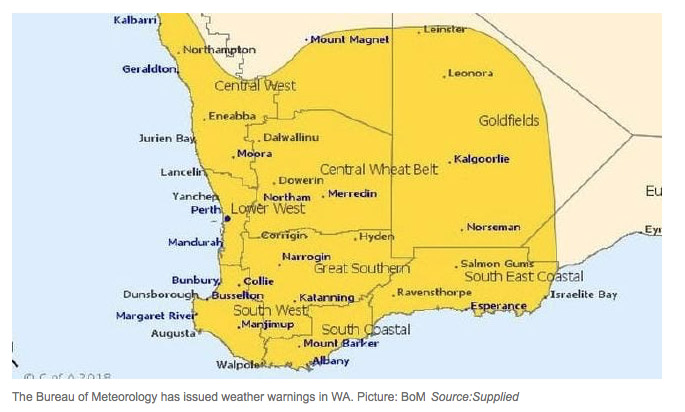
Warning from Western Australia showing the area of impact identified by the Bureau of Meteorology (BOM)
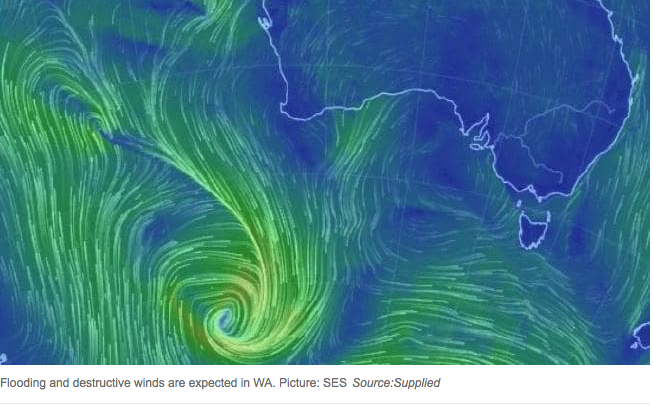
This is some pretty serious weather coming through with the website identifying flooding and destructive winds. Probably best to sit at home when its like this, although I didn’t
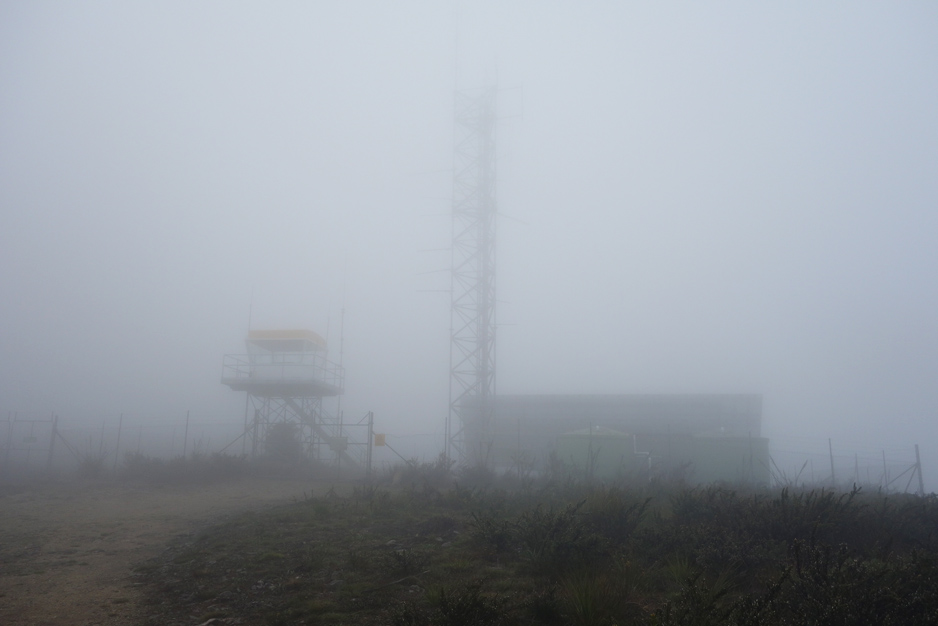
So much for the panoramic views at the summit. Even without the views the mist created an ‘otherworldly’ feel that made this a very enjoyable walk that we would have missed had we decided not to go.
On the trail, what now?
So you are out hiking, you’ve checked the weather forecast and have catered for the expected weather when something totally unexpected comes through. So what do we do?
If possible take a break in a sheltered area if the conditions are really that bad. If there is no shelter to be had and you have the right gar for the weather, then keep on going. If the weather is really that bad and it’s an option, then pull the pin and leave the trail. It’s your call.
Gear
What this all comes down to is that it is not the weather that is the real issue here.
In fact there is a well known saying that applies to outdoor adventure activities that goes
“There is no such thing as bad weather, only bad clothing”.
If you have the appropriate clothing, including such things as wet weather gear then you will cope with just about whatever nature throws at you; almost
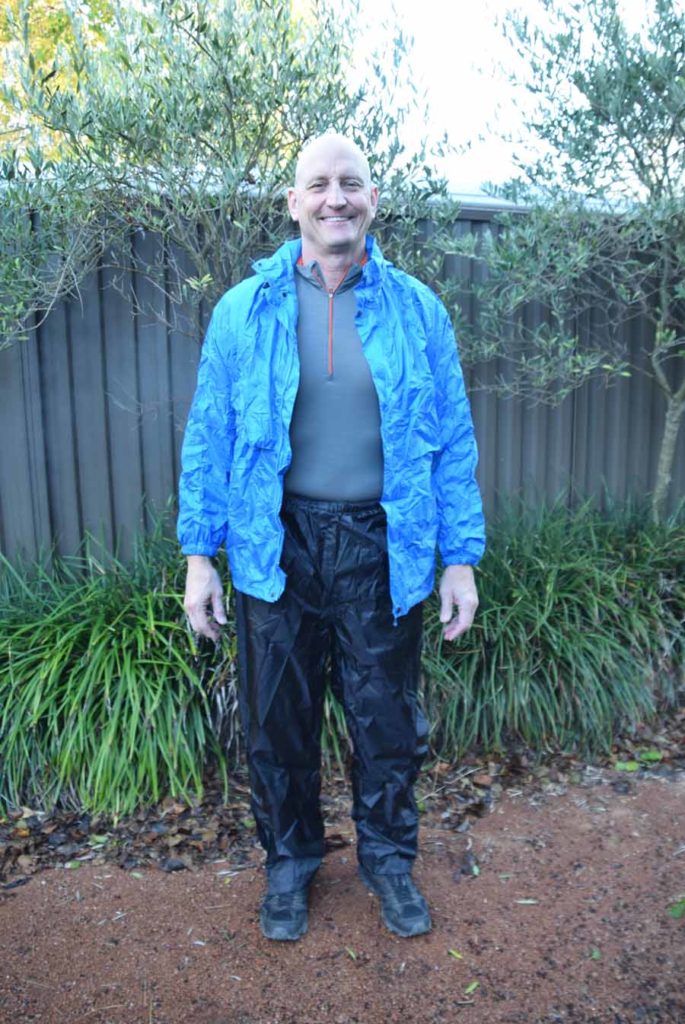
If rain is forecast carry at least a rain jacket and preferably rain pants as well
Associated Weather issues
But let’s say you have checked the weather and you have packed all the correct equipment to keep you warm/cool there are still other considerations we need to take into account that come up because of the weather.
Dehydration/heat
There comes a time when it just becomes too hot to hike and it can present a danger to your health to do so. If the forecast temperature for the day is in the mid to high 30’s then reconsider you hike or change your plans to start and finish earlier. If you are still hiking in hot conditions, then make sure you have sun protection and plenty of water.
Extreme cold
There is nothing wrong with hiking in cold conditions, even in snow providing you have the appropriate equipment and experience. But the level of preparation and experienced required to hike in these conditions increases and if you aren’t prepared or skilled enough then think about other options such as changing your trip or bringing along someone who is experienced in these conditions.
Bushfires
You could be forgiven for thinking that Australia is the only country in the world that has bushfires but both areas of Europe and the USA are also impacted by fires on a regular basis. Some trails such as the Heysen Trail in South Australia are closed between November – April. Other trails such as the Bibbulmun Track in Western Australia strongly deter people from doing a thru hike during the summer months. These trails make it easy but what about our own local trails? Check the fire conditions in your local area and if there is a high or extreme fire danger change your plans and avoid remote areas particularly if there are already fires burning nearby as they can change direction often without warning.
Strong winds
Much of my hiking is done in the Australian Alps close to Canberra and it’s not unusual during periods of high winds and heavy rains for large healthy trees to come down. In March of 2016 we did a shakedown hike for our upcoming Larapinta Trail trip in the Cotter flat area of the Bimberi Wilderness and we had those conditions that I just described. During the night we heard five very large trees coming down. The lesson here for this area is camp in the open and not under large trees. While the whole tree may not come down large limbs may drop without warning and you don’t want to be camping underneath them when they do.
Last word
In most case misreading the weather may mean that you’re going to have a miserable day but get it really wrong and it could become life threatening. From my perspective there really is no such thing as perfect weather for hiking so long as you have the right equipment for the conditions that you are presented with and this is where paying attention to the weather conditions before you head out on your adventure is so important and forms part of standard trip planning.
As mentioned if things go pear shape on your trip even though they haven’t been forecast, then don’t be afraid to HYOH even if this means quitting the trail.